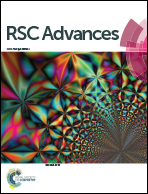Efficient tuning of zinc phthalocyanine-based dyes for dye-sensitized solar cells: a detailed DFT study†
Abstract
The growing energy demand speed up the designing of competent photovoltaic materials. Herein, five zinc phthalocyanine-based donor materials T1–T5 are designed by substituting various groups (isopropoxy, cyano, fluoro, methoxycarbonyl, and dicyanomethyl) around zinc phthalocyanine. B3LYP/6-31G (d,p) level density functional theory (DFT) was used to investigate the optoelectronic properties of five zinc phthalocyanine-based dyes T1–T5 for dye-sensitized solar cells. The designed molecule T1 shows maximum absorption wavelength (λmax) in the absorption spectrum at 708.89 and 751.88 nm both in gaseous state and in THF (tetrahydrofuran) solvent. The Eg value of T1 (1.86 eV) is less than reference R, indicating a greater charge transfer rate for T1 among the molecules. The values of open-circuit voltages achieved with acceptor polymer PC71BM are higher than R except for T1 and are 0.69 V, 1.95 V, 1.20 V, 1.44 V, and 1.84 V for T1, T2, T3, T4, and T5, respectively. The lower the reorganization energy, the higher the charge transfer for T1 due to its lower hole mobility (0.06297 eV) than R. Thus, the designed T1–T5 molecules are expected to exhibit superior performance in dye-sensitized solar cells.



 Please wait while we load your content...
Please wait while we load your content...